Decent video explaining why you should leave an empty chamber on older single action revolvers. I suppose this video is just a PSA for anyone thats thinking about using their old single action as a EDC. I knew they started with an empty chamber when shooting cowboy, but didn't really give any thought to as why. I have always personally loaded all 6 rounds, but that has always been at the range, on the line ready to shoot anyways.
-
If you enjoy the forum please consider supporting it by signing up for a NES Membership The benefits pay for the membership many times over.
You are using an out of date browser. It may not display this or other websites correctly.
You should upgrade or use an alternative browser.
You should upgrade or use an alternative browser.
Leaving an empty chamber on older single action revolver
- Thread starter Nick Leduc
- Start date
I suppose I'll link it for the curiousHickok45 did a good video on this too
gerrycaruso
NES Member
For those who wish to eliminate the possibility of an accidental discharge how about this. Before metalic cartridges were invented, percussion revolvers could be carried with the hammer down between 2 chambers. Some had notches or pins for the hammer nose. Couldn't a modern single action be carried with the firing pin resting between the rims of 2 cartridges?
1. Modern single actions have a transfer bar safety.....so you already can carry 6 in a modern one......by "modern" SA i mean like.....1970sFor those who wish to eliminate the possibility of an accidental discharge how about this. Before metalic cartridges were invented, percussion revolvers could be carried with the hammer down between 2 chambers. Some had notches or pins for the hammer nose. Couldn't a modern single action be carried with the firing pin resting between the rims of 2 cartridges?
2. A modern sa would require major modification to do what you are suggesting. They are indexed so that the hammer only falls straight down on a chamber squarely. Remember.....the cylinder only spins freely on half cock on some and when the loading gate is open on others. Once you return the hammer to the down position its indexing will ensure it is over a cylinder.
But I digress to point number 1. Modern sa revolvers have transfer bars so no need to worry where the hammer is resting. Just load all cylinders and holster it.
Edit.....looked it up and ruger started putting transfer bars on all their single actions in 1973. They still have an offer to convert any pre 1973 revolvers to transfer bars for free. Most purists choose not to convert them though.
Last edited:
Older gun? No transfer bar safety i assume?I knew a guy who had a fully loaded 44 hit the floor and destroyed his leg. Eventually had it removed. Lesson learned the hard way.
This applies to old single actions without any kind of transfer bar safety. Modern single actions such as the Ruger Blackhawk, can be carried with all six loaded. Be sure that your model has that feature. I have a cap and ball Pietta Remington 1858 that has safety notches between chambers, state of the art technology for the time period. It’s become my favorite shooter as of late, due to the ammo shortage. Blackpowder components are relatively plentiful compared to centerfire ammo.
I've got a frontier scout .22 single action revolver. Before "half-cocked" is a position that keeps the hammer from resting on the chamber.
Is this an anomaly?
Is this an anomaly?
It may be a notch in the sear, not related.I've got a frontier scout .22 single action revolver. Before "half-cocked" is a position that keeps the hammer from resting on the chamber.
Is this an anomaly?
Had what removed?I knew a guy who had a fully loaded 44 hit the floor and destroyed his leg. Eventually had it removed. Lesson learned the hard way.
- Joined
- Jul 28, 2016
- Messages
- 499
- Likes
- 626
I've got a frontier scout .22 single action revolver. Before "half-cocked" is a position that keeps the hammer from resting on the chamber.
Is this an anomaly?
On most guns that have a half cock position like that, the half cock position would not pass drop safety tests, and is not safe for carry. The half cock may seem solid, but usually, not much metal would need to shear before the hammer could drop. This is very different from the safety provided by a transfer bar, where there is just nothing for the hammer to strike, unless the trigger is pulled, which moves the transfer bar over the firing pin.
As far as I know, the only safe ways to carry a single action revolver involve the hammer being fully down, and resting in a place where a blow to the hammer cannot cause a discharge.
Unless the revolver has a transfer bar. Those with this feature are safe to carry fully loaded.On most guns that have a half cock position like that, the half cock position would not pass drop safety tests, and is not safe for carry. The half cock may seem solid, but usually, not much metal would need to shear before the hammer could drop. This is very different from the safety provided by a transfer bar, where there is just nothing for the hammer to strike, unless the trigger is pulled, which moves the transfer bar over the firing pin.
As far as I know, the only safe ways to carry a single action revolver involve the hammer being fully down, and resting in a place where a blow to the hammer cannot cause a discharge.
- Joined
- Nov 16, 2014
- Messages
- 23,988
- Likes
- 30,127
Couldn't you just carry it cocked? I'm asking i only shoot striker fired... but wouldn't most have a drop safety like a 1911?On most guns that have a half cock position like that, the half cock position would not pass drop safety tests, and is not safe for carry. The half cock may seem solid, but usually, not much metal would need to shear before the hammer could drop. This is very different from the safety provided by a transfer bar, where there is just nothing for the hammer to strike, unless the trigger is pulled, which moves the transfer bar over the firing pin.
As far as I know, the only safe ways to carry a single action revolver involve the hammer being fully down, and resting in a place where a blow to the hammer cannot cause a discharge.
Carrying a revolver with the hammer cocked and loaded is asking for a negligent discharge. It’s not like a 1911 with a manual and grip safety or like a DA/SA with a decocker. Single actions have a primitive manual of arms.Couldn't you just carry it cocked? I'm asking i only shoot striker fired... but wouldn't most have a drop safety like a 1911?
- Joined
- Nov 16, 2014
- Messages
- 23,988
- Likes
- 30,127
FairCarrying a revolver with the hammer cocked and loaded is asking for a negligent discharge. It’s not like a 1911 with a manual and grip safety or like a DA/SA with a decocker. Single actions have a primitive manual of arms.
First, this particular gun is ONLY ever loaded at the firing line. It's never carried, but I'm curious.On most guns that have a half cock position like that, the half cock position would not pass drop safety tests, and is not safe for carry. The half cock may seem solid, but usually, not much metal would need to shear before the hammer could drop. This is very different from the safety provided by a transfer bar, where there is just nothing for the hammer to strike, unless the trigger is pulled, which moves the transfer bar over the firing pin.
As far as I know, the only safe ways to carry a single action revolver involve the hammer being fully down, and resting in a place where a blow to the hammer cannot cause a discharge.
I've attached pics of the hammer resting, quarter-cocked (cylinder will not rotate), half-cocked (cylinder will rotate) and fully cocked.
Also, does the last pic show a transfer bar? I really don't know what that means. Edit: NM - it's not a transfer bar. Yootoob showed me what a transfer bar is.
Attachments
-
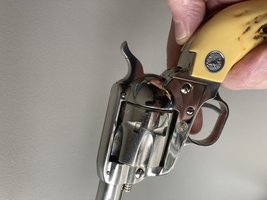 9404DEF3-8167-4364-891E-71AF557154F3.jpeg33.1 KB · Views: 26
9404DEF3-8167-4364-891E-71AF557154F3.jpeg33.1 KB · Views: 26 -
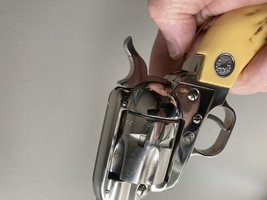 C6BD4E90-02FD-4327-944A-715FDB173975.jpeg33.5 KB · Views: 21
C6BD4E90-02FD-4327-944A-715FDB173975.jpeg33.5 KB · Views: 21 -
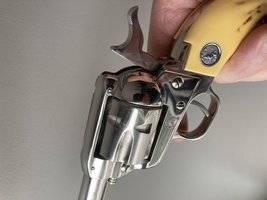 B83FB0EB-256D-4426-9206-BD380FF17B38.jpeg32.7 KB · Views: 23
B83FB0EB-256D-4426-9206-BD380FF17B38.jpeg32.7 KB · Views: 23 -
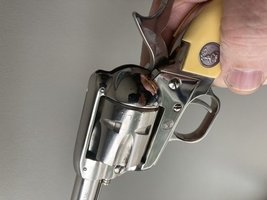 1DA161CE-03F6-4294-92F7-78A090C105BC.jpeg32.5 KB · Views: 26
1DA161CE-03F6-4294-92F7-78A090C105BC.jpeg32.5 KB · Views: 26 -
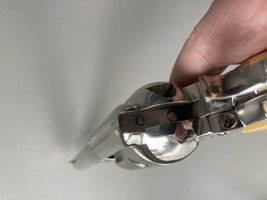 A947EA13-BEE1-478C-999F-BF2083209285.jpeg24.2 KB · Views: 24
A947EA13-BEE1-478C-999F-BF2083209285.jpeg24.2 KB · Views: 24
Last edited:
J B Books, as portrayed by John Wayne in the movie "The Shootist" explained it best when he was giving a shooting lesson to Ron Howard's character Gillum Rogers.
- 00:56:12 Aim well and put five slugs in it.
- 00:56:15 Why not six?
- 00:56:16 You keep your hammer on an empty chamber for safety.
- 00:56:19 And if you're going out to face somebody?
- 00:56:22 Load six if your insides tells you to.
Great movie.J B Books, as portrayed by John Wayne in the movie "The Shootist" explained it best when he was giving a shooting lesson to Ron Howard's character Gillum Rogers.
- 00:56:12 Aim well and put five slugs in it.
- 00:56:15 Why not six?
- 00:56:16 You keep your hammer on an empty chamber for safety.
- 00:56:19 And if you're going out to face somebody?
- 00:56:22 Load six if your insides tells you to.
John Waynes Rooster Cogburn covered that topic a few years earlier in True GritJ B Books, as portrayed by John Wayne in the movie "The Shootist" explained it best when he was giving a shooting lesson to Ron Howard's character Gillum Rogers.
- 00:56:12 Aim well and put five slugs in it.
- 00:56:15 Why not six?
- 00:56:16 You keep your hammer on an empty chamber for safety.
- 00:56:19 And if you're going out to face somebody?
- 00:56:22 Load six if your insides tells you to.
Mattie: wait ill get my revolver!
Rooster: what for so you can shoot your own foot off?
Mattie (watching rooster load his revolver) why do you keep that one chamber empty?
Rooster: so I dont shoot my foot off!
gerrycaruso
NES Member
Not all modern single actions have a transfer bar. Don't the Colt SAA and all the Uberti clones use the original action without a transfer bar? There are also plenty of old model Ruger Blackhawks and Super Blackhawks still in use.
That is true.Not all modern single actions have a transfer bar. Don't the Colt SAA and all the Uberti clones use the original action without a transfer bar? There are also plenty of old model Ruger Blackhawks and Super Blackhawks still in use.
Referring to your previous post about dropping the hammer between cylinders......it doesn't work like that on SAA clones and old rugers. They are timed so that the hammer only falls on a cylinder. I may be ignorant as to some ultra rare single action cartridge gun that has notches between cylinders......but for the multitude of sa cartridge guns out there......no transfer bar means leave one cylinder empty and hammer over that one. If it has a transfer bar load all cylinders no problem.
gerrycaruso
NES Member
I thought perhaps I was mistaken so I went to the gun safes and took out an old model Blackhawk, an old model Super Blackhawk, an Uberti open top and a Colt SAA. All allowed me to lower the hammer between chambers. I'm not saying it's a great idea, only that it's possible.
AHM
NES Member
May want to edit those photos.I've attached pics of the hammer resting, quarter-cocked (cylinder will not rotate), half-cocked (cylinder will rotate) and fully cocked.
We can see your face reflected.
Well, except that it's so shiny I've been struck blind;
but let that go.
When its between chambers like that.....does the cylinder easily rotate and click locked with the hammer over the chamber again?I thought perhaps I was mistaken so I went to the gun safes and took out an old model Blackhawk, an old model Super Blackhawk, an Uberti open top and a Colt SAA. All allowed me to lower the hammer between chambers. I'm not saying it's a great idea, only that it's possible.
Fixxah
NES Member
His leg.Had what removed?
gerrycaruso
NES Member
The cylinder will rotate easily if it's empty but when it's loaded, the firing pin is between 2 cartridge rims preventing cylinder movement. The only time I can think of where it wouldn't work is if the rims sit in a recess. I think the Super Blackhawk is like that but not the Blackhawk. I'll have to go look.
This is the way old single actions had 4 clicks, before transfer bar safeties. first click is a safe position, second click is half cocked allowing the cylinder to move and be loaded and unloaded, third click fully cocked, pull the trigger and boom fourth click, hammer down. I have a old Ruger bearcat that has all the clicks.I've got a frontier scout .22 single action revolver. Before "half-cocked" is a position that keeps the hammer from resting on the chamber.
Is this an anomaly?
Regarding the Uberti's, if I'm not mistaken the 1873 Cattleman uses the original SAA action and has no transfer bar. However, the Cattleman II versions, introduced a few ago has what they call a 'retractable firing pin'.Don't the Colt SAA and all the Uberti clones use the original action without a transfer bar?
Fixxah
NES Member
Old .44mag Ruger.Older gun? No transfer bar safety i assume?
Share:
Similar threads
- Replies
- 2
- Views
- 157
